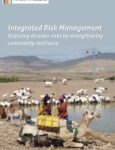To address disaster risks effectively, risk reduction interventions should address integrate timescales and geographical scales. Climate variability and change necessitate the assessment of risks in the short term (weather forecasts) as well as in the medium (seasonal forecast) and long-term (climate change), which impact on the type, frequency, intensity and predictability of risks. The wider landscape should also be taken into account since the place where risks arise is in most cases spatially remote from the place where they become manifest. Moreover, the function of ecosystems as buffer for hazards such as droughts or floods and as a source for livelihoods should be recognized.
The integration of climate and ecosystems into disaster risk reduction is referred to as Integrated Risk Management. With the integration of these three approaches, several other key aspects of IRM can be identified. To make communities strong and robust, a resilience approach should consider and address the multiple, simultaneous and often re-enforcing drivers of risks that affect livelihoods. This may also include a focus on (inter alia) health, water, sanitation and hygiene, education, and gender equality. Recognizing that development and ‘business as usual’ can increase risk (the risk for) disasters, and disasters can affect development, both domains should thus be interrelated.
Intergrated-Risk-Management

